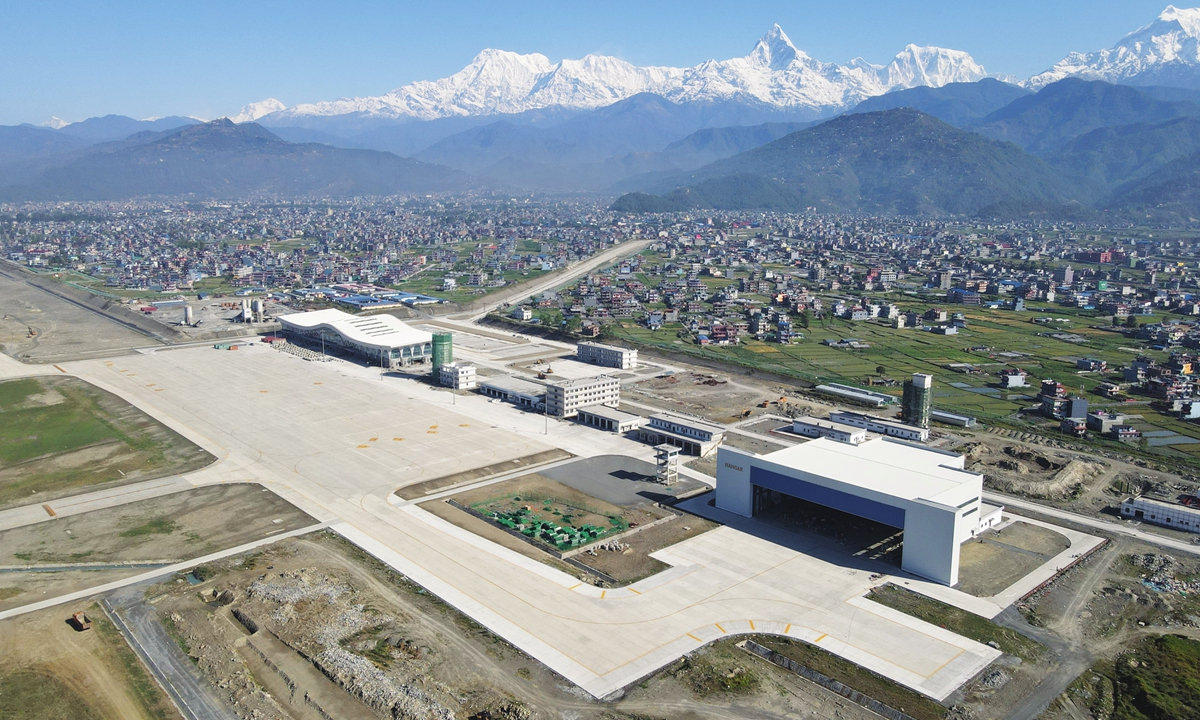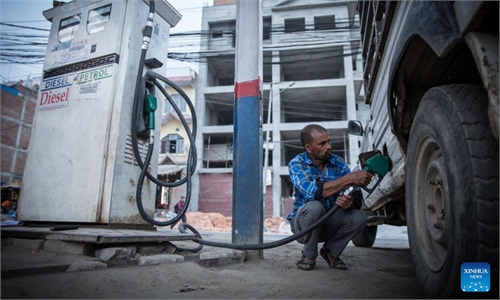Nepal a 'demonstration garden' for friendly cooperation among countries, not a 'fighting ring' for geopolitical games: envoy
South Asian nation a ‘demonstration garden’ for friendly cooperation, not a ‘fighting ring’ for geopolitical games

Chinese Ambassador to Nepal Hou Yanqi Photo: Courtesy of the Chinese Embassy in Nepal
Editor's note:
During the Chinese State Councilor and Foreign Minister Wang Yi's recent visit of to Nepal in March, he stated to the Nepali Foreign Minister Narayan Khadka three supports from China for Nepal - supporting Nepal to pursue a development path that suits its own national conditions, to pursue an independent domestic and foreign policy, and to more deeply participate in the construction of the Belt and Road Initiative (BRI).
Nepal is an important partner of China's construction of the Belt and Road in South Asia, and the two countries signed the Memorandum of Understanding on the BRI cooperation in 2017. In an exclusive interview with the Global Times (GT) reporters Yin Yeping, Chinese Ambassador to Nepal Hou Yanqi (Hou) shared her view on the bilateral cooperation between the two nations under the BRI. She stressed Nepal should become a "demonstration garden" for friendly cooperation among countries, not a "fighting ring" for geopolitical games.
GT: What do you think of the significance of Wang's visit under the current international situation?
Hou: Nepal is China's good neighbor and good friend. The two countries have always respected each other's sovereignty and territorial integrity, not interfering in each other's internal affairs, while watching over each other and sharing a common destiny, setting a model for countries big and small to treat each other as equals and to cooperate for win-win results.
At present, great changes unseen in a century are intertwined with a major epidemic rarely seen in this century.
While the international situation and landscape are rapidly evolving in depth, and world peace and development are facing new challenges, both China and Nepal are facing with the important task of fighting the epidemic and promoting economic and social development.
Wang's visit to Nepal at this time fully reflects the importance and support China attaches to its friendly neighbor Nepal.
During the talks with Narayan Khadka, Foreign Minister of Nepal, Wang clearly stated three supports from China for Nepal -- supporting Nepal to pursue a development path that suits its own national conditions, to pursue an independent domestic and foreign policy, and to more deeply participate in the construction of the BRI.
These three areas of support send a very positive signal to the Nepali side, that is, China's friendly policy is aimed at all parties and people in Nepal in deepening mutually beneficial cooperation and achieving common development.
Through this visit, the two sides reiterated their respect for each other's national interests and core concerns, and agreed to speed up the joint construction of the Belt and Road and gradually build a Trans-Himalayan Multi-dimensional Connectivity Network, so as to make the Himalayas a bond of friendly cooperation between the two countries, and to promote the development of the two countries' cooperation.
Cooperation in the fields of medical and health care, economy and trade, people-to-people and cultural engagement, connectivity has helped Nepal recover its economy after the COVID-19 epidemic and help Nepal realize the transformation from a land-locked country to a land-linked country.
China and Nepal will also jointly resist unilateralism and oppose power politics. The Chinese side appreciates the Nepali side's firm support for the global development initiative, and is willing to work with the Nepali side to accelerate the promotion of the UN 2030 Agenda for Sustainable Development.
In a word, this visit has consolidated the traditional friendship between China and Nepal, enhanced mutual understanding, deepened strategic mutual trust, clarified key cooperation directions and important areas, effectively promoted the implementation of the consensus reached by the leaders of the two countries, and promoted the bilateral relations and pragmatic cooperation in various fields into a new level.
GT: Previously, foreign media reported that the China-Nepali cross-border railway project was in a "stagnant state." Is this true? What are the difficulties of China-Nepali cooperation under the BRI?
Hou: The construction of the China-Nepal cross-border railway is an important consensus reached by the leaders of the two countries in the field of connectivity, and it is also the earnest expectation of the two peoples.
The railway departments of the two countries have coordinated and communicated with each other for many times, completed the pre-feasibility study and other preparations, and made important progress.
During Wang's visit to Nepal, the two sides signed the technical assistance plan for the feasibility study project of the China-Nepal cross-border railway project, laying a solid foundation for the next step to promote the project implementation.
At the same time, it should be noted that the project needs to cross the Himalayas. The less than 200-kilometer section of road has a drop height of over 1,000 meters. That means that it needs to solve many technical problems such as complex geological conditions and frequent natural disasters along the way. According to preliminary calculations, the bridge-to-tunnel ratio of the entire railway exceeds 90 percent, and the construction cost per kilometer is about 200 million yuan.
In addition, this project, like many other infrastructure projects in Nepal, also faces a series of challenges such as the epidemic, land acquisition, demolition and ecological protection.
It is hoped that the authorities of both countries to strengthen communication and coordination, and in the spirit of science, overcome difficulties and make contributions for a long time.
It is also hoped that the Nepali side will further improve the business environment, strengthen policy stability and support, and promote the practical implementation of large-scale infrastructure projects such as cross-border railways, so as to realize the common dream of the two peoples at an early date.

The Pokhara International Airport, built with the help of the Chinese government, is expected to be completed in July 2022. Courtesy of the Chinese Embassy in Nepal
GT: The Nepali parliament recently passed the Millennium Challenge Compact (MCC), which is believed to be part of the US "Indo-Pacific strategy." Some foreign media reported that this plan will compete with the BRI. What do you think of this? How are the two different?
Hou: Nepal should become a "demonstration garden" for friendly cooperation among countries, not a "fighting ring" for geopolitical games.
China and Nepal have carried out fruitful cooperation in infrastructure construction covering roads, airports, electric power and water conservancy.
This is due to the advantages of China, in terms of technology, experience and capital, as well as the fact that China and Nepal are connected by mountains and rivers and geographically adjacent. It is also because the Chinese people are sincere and selfless toward the Nepalese people, supporting the friendship with Nepal without any conditions attached.
It can be said that there is no other country that can replace the advantages that China and Nepal have in the BRI cooperation.
Although the pace of pragmatic cooperation between the two countries has slowed down due to factors such as the epidemic and changes in the political situation in Nepal, there is a Chinese saying that "a distance knows horsepower, and a long time sees people's hearts."
I believe nothing can interfere with the great cooperation between the two countries. The people of Nepal have benefited and will continue to benefit from the BRI. I have full confidence in that.
It should be pointed out that China's support for Nepal is aimed at promoting Nepal's economic and social development, improving the living standards of Nepali people, fully respecting its national sovereignty and dignity, while never interfering in Nepal's internal affairs, and not competing with any other country, nor engaging in geopolitical games in Nepal.
China understands and respects that Nepal, as a least developed country, needs to use various resources to develop its own economy, and is happy to see Nepal getting along with other countries.
It is hoped that the international community can provide sincerer support for Nepal's national development and help the country realize the UN 2030 Agenda for Sustainable Development at an early date.
GT: Could you please brief us on the achievements of the joint construction of projects under the BRI?
Hou: Since the signing of the Memorandum of Understanding on the BRI cooperation between the two countries in 2017, positive progress has been made in cooperation in various fields such as connectivity, economic and trade investment, infrastructure, and people-to-people and cultural exchanges, making important contributions to Nepal's economic and social development. In 2021, the trade volume between China and Nepal reached $1.98 billion, a year-on-year increase of 67 percent, of which Nepal's exports to China rose by 63 percent.
In its cooperation with Nepal, China pays attention to the characteristics of Nepal's national conditions, and helps Nepal leverage its own advantages, while sharing China's opportunities and speeding up the development and revitalization of Nepal.
For example, Nepal is inland, facing challenges caused by undeveloped road conditions and difficulty in connecting with the outside world, which has become a bottleneck for the development of Nepal's country.
The old Chinese saying goes "if you want to get rich, build roads first."
In recent years, the Chinese side has helped Nepal complete the construction of the third phase of the Anigo Highway project, the first phase of the reconstruction of the Kathmandu inner ring road, and a series of road infrastructure projects such as the Post-Disaster Recovery Project of the Tatopani Frontier Inspection Station.
With the joint efforts of China and Nepal, the two sides have overcome the difficulties of the epidemic, and the efficiency of one-way cargo passing at the Kerung-Rasuwagadhi Port has been gradually improved. Currently, 14 containers pass through the port each day.
These projects have greatly improved the traffic and logistics conditions of Nepal's roads and provided assistance for the recovery and development of Nepal's economy.
For another example, Nepal is among the world least developed countries, and its basic infrastructure is still developing. In recent years, the restoration of Durbar High School, Civil Service Hospital of Nepal, and the Public School Recovery Project in Dolakha, which were built with Chinese aid, have been completed or completed their mid-term acceptance.
Meanwhile, a number of livelihood improvement projects such as the Public School Recovery Project and the Hospital Recovery Project in Sindhupalchok are about to start construction.
Thirteen groups of Chinese medical personnel in Nepal have worked successively in Nepal's hospitals, relieved the pain of many local people, and trained front-line doctors.
This cooperation directly serves the people of Nepal and have made important contributions to improving their living standards and promoting the progress of Nepalese society.
According to statistics, Nepal's hydropower reserves amount to 83,000 megawatts, accounting for about 2.3 percent of the world's hydropower reserves, making it the second largest inland water resource country.
Making full use of clean energy to meet its own needs and earn foreign exchange through exports will become an important means for Nepal to protect the environment and achieve economic development.
With the support of China, a number of hydropower projects, such as Upper Marsyangdi-A Hydropower Station and Upper Trishuli 3A Hydroelectric Project, have been launched one after another, and a number of industrial projects using clean energy have been put into production. These not only alleviate the problem of power shortage in Nepal, but also create a large number of jobs for Nepal, while cultivating many technical talents, and playing an important role in promoting the economic development of Nepal.
GT: During the visit to Nepal, Wang attended the completion ceremony of the Pokhara International Airport project via video link. Could you please brief us on the air connectivity between China and Nepal?
Hou: For a landlocked country like Nepal, air transport is an important channel for communicating with the outside world and attracting foreign tourists to visit Nepal. At present, Nepal's only international airport, Tribhuvan International airport in Kathmandu, can no longer meet the needs of its international connectivity.
China attaches great importance to the needs of Nepal's air transportation infrastructure construction, and strengthens air connectivity with Nepal, taking it as an important cooperation content in the joint construction of the Belt and Road between the two countries.
The Pokhara International Airport, which the Chinese government helped build in Nepal, is a typical example. The project started in July 2017, and China provided a soft loan to Nepal for this project, which not only created a new model of development cooperation between the two countries, but also effectively guaranteed the smooth implementation of the project.
After the airport construction and installation project is completed, follow-up work will also be carried out, and the overall construction is expected to be completed in July 2022. According to statistics, during the implementation of this project, nearly 1,000 Nepalese engineering and technical talents have been trained. Pokhara is an internationally renowned tourist city, and the transportation effect of the airport will be immeasurable in the future.
Chinese enterprises have also successively undertaken the reconstruction project of the runway and smooth track of Tribhuvan International Airport and the upgrading and reconstruction project of Gautam Buddha International Airport.
Chinese enterprises have actively participated in the construction and upgrading of the three international airports in Nepal, which fully reflects China's advantages in large-scale infrastructure construction and become the biggest contributors to the external communication of Nepal's air.
In addition, China and Nepal jointly established Himalaya Airlines in 2014. At present, the company operates more than 10 routes, playing a fundamental role, especially in helping Nepal overcome the epidemic.
In the future, the Chinese side will help Nepal further improve the air transportation network, promote the development of Nepali air transport, tourism and other related industries, as well as facilitate economic and trade cooperation and personnel exchanges between the two countries.

